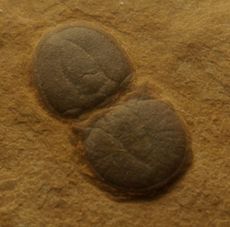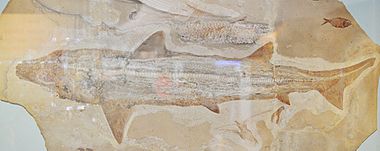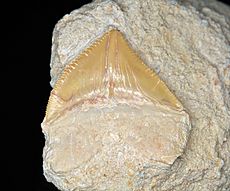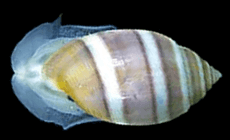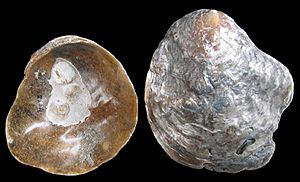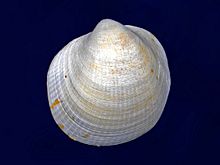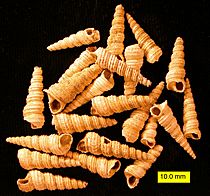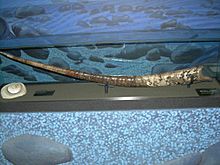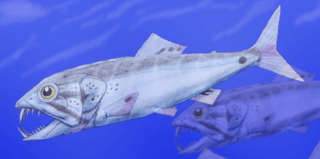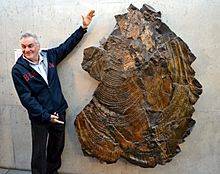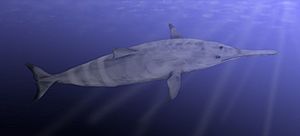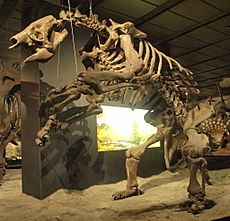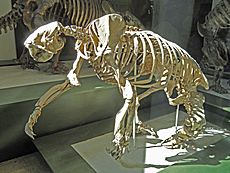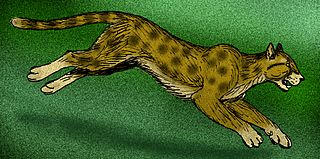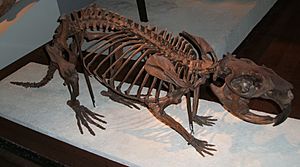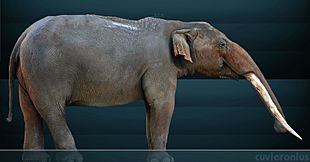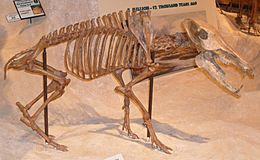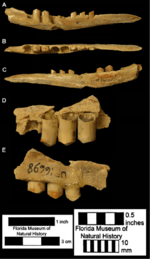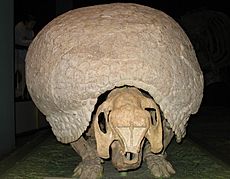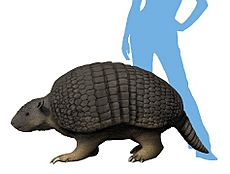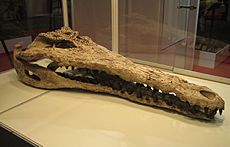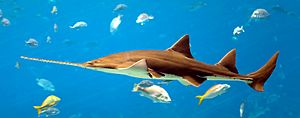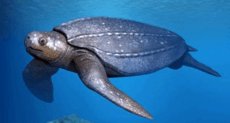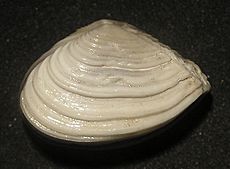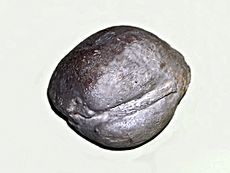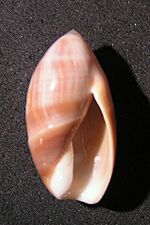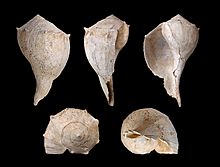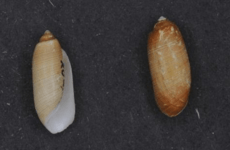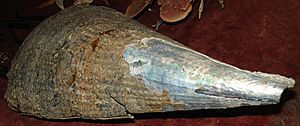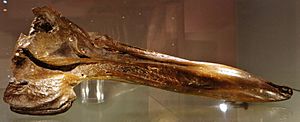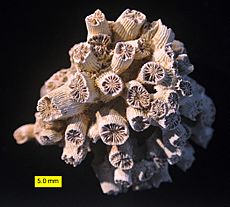List of the prehistoric life of South Carolina facts for kids
This article is about the amazing ancient life that once lived in South Carolina, long before humans walked the Earth. Scientists study fossils, which are the preserved remains or traces of these ancient creatures, to learn about what South Carolina was like millions of years ago. From tiny sea creatures to giant sharks and huge mammals, South Carolina has a rich history of prehistoric life!
Contents
Paleozoic Era: Ancient Sea Life
The Paleozoic Era was a very long time ago, from about 541 to 252 million years ago. During this time, South Carolina was mostly covered by a shallow sea. This means that many of the fossils found from this period are of sea creatures.
One of the most common types of fossils found from this era are trilobites. These were ancient sea bugs with hard shells, a bit like modern crabs or lobsters, but they are now extinct. They crawled along the seafloor or swam in the water.
- †Agraulos
- †Hypagnostus
- †Paradoxides
- †Peronopsis
- †Ptychagnostus
- †Skreiaspis
Mesozoic Era: Age of Reptiles and More
The Mesozoic Era, often called the "Age of Dinosaurs," lasted from about 252 to 66 million years ago. While we don't find dinosaur fossils in this list for South Carolina, this period was still full of incredible life, especially in the seas that covered parts of the state.
Many of the fossils from this time are from marine animals like sharks, bony fish, and various kinds of mollusks (like snails and clams).
- Ancient Sharks:
- †Cretalamna: An ancient shark that swam in the seas.
- Squalicorax: Also known as the "crow shark," this shark had serrated teeth perfect for cutting.
- Carcharias: A type of sand tiger shark.
- Sea Snails and Clams:
- †Acteon: A type of sea snail.
- †Anomia: A jingle shell, a type of clam.
- Glycymeris: A bittersweet clam.
- Turritella: A tower snail with a tall, spiral shell.
- Other Marine Life:
- †Baculites: A type of ammonite, which were ancient sea creatures related to modern squids and octopuses, but with coiled or straight shells.
- †Enchodus: Known as the "saber-toothed herring" because of its long, sharp teeth.
-
†Mosasaurus: A giant marine reptile that was a top predator in the ancient seas.
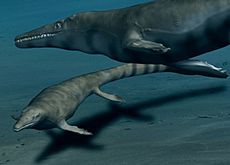 Life restoration of two of the Late Cretaceous Mosasaurus
Life restoration of two of the Late Cretaceous Mosasaurus - †Inoceramus: A very large type of clam.
Cenozoic Era: Age of Mammals
The Cenozoic Era began about 66 million years ago and continues to the present day. This is often called the "Age of Mammals" because mammals became very common and diverse during this time. South Carolina has many amazing Cenozoic fossils, including ancient whales, giant ground sloths, and even saber-toothed cats!
Mammals of the Cenozoic
- Ancient Whales and Dolphins:
-
†Basilosaurus: A very long, snake-like ancient whale.
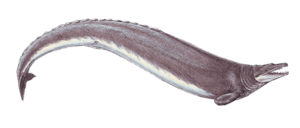 Life restoration of the Eocene whale Basilosaurus
Life restoration of the Eocene whale Basilosaurus -
†Dorudon: A smaller, dolphin-like ancient whale.
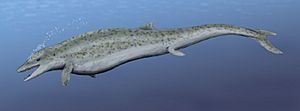 Life restoration of the Eocene whaleDorudon
Life restoration of the Eocene whaleDorudon - †Squalodon: An ancient dolphin with shark-like teeth.
-
†Tursiops truncatus: The common bottlenose dolphin, which still lives today.
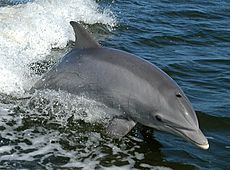 A living Tursiops truncatus, or common bottlenose dolphin
A living Tursiops truncatus, or common bottlenose dolphin
-
- Giant Land Mammals:
-
†Mammut americanum: The American mastodon, a large elephant-like creature with shaggy fur.
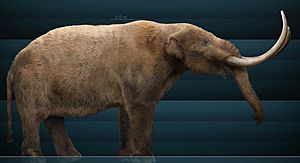 Restoration of a Mammut americanum, or American mastodon
Restoration of a Mammut americanum, or American mastodon - †Mammuthus columbi: The Columbian mammoth, another huge elephant relative.
- †Eremotherium: A giant ground sloth, much larger than sloths today.
- †Megalonyx: Another type of large ground sloth.
-
†Arctodus: The short-faced bear, one of the largest bears to ever live.
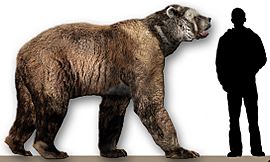 Restoration of an Arctodus, or short-faced bear, with a human to scale
Restoration of an Arctodus, or short-faced bear, with a human to scale -
†Smilodon: The famous saber-toothed cat, known for its incredibly long canine teeth.
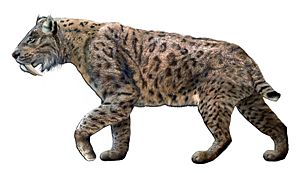 Life restoration of the Pleistocene-Holocene saber-tooth cat Smilodon
Life restoration of the Pleistocene-Holocene saber-tooth cat Smilodon - †Miracinonyx: The American cheetah, a fast predator that lived in North America.
- †Castoroides: A giant beaver, as big as a black bear!
- †Cuvieronius: An elephant relative with spiral tusks.
- †Mylohyus: An ancient peccary, similar to a wild pig.
- †Dasypus bellus: The beautiful armadillo, an extinct relative of today's armadillos.
- †Glyptotherium: A large, armored armadillo relative.
- †Holmesina: Another type of giant armadillo relative.
-
†Canis dirus: The dire wolf, a powerful ancient wolf.
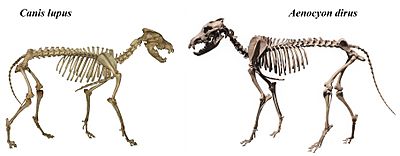 Modern mounted skeleton of Canis lupus, the grey wolf, to scale with a fossilized skeleton of the Pleistocene wolf Canis dirus, or dire wolf
Modern mounted skeleton of Canis lupus, the grey wolf, to scale with a fossilized skeleton of the Pleistocene wolf Canis dirus, or dire wolf -
†Alligator mississippiensis: The American alligator, which has lived in South Carolina for a very long time.
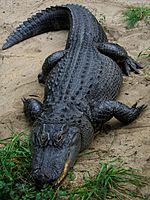 A living Alligator mississippiensis, or American alligator
A living Alligator mississippiensis, or American alligator - †Thecachampsa: An ancient crocodile relative.
- †Gavialosuchus: Another ancient crocodile relative.
-
- Marine Life of the Cenozoic:
-
†Otodus megalodon: The most famous ancient shark, a gigantic predator that ruled the oceans.
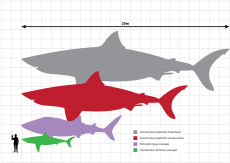 Diagram illustrating the largest (grey) and most conservative (red) size estimates of the Miocene-Pliocene shark Carcharocles megalodon (sometimes Carcharodon or Otodus megalodon) with a whale shark (violet), great white shark (green), and anachronistic human (black) to scale
Diagram illustrating the largest (grey) and most conservative (red) size estimates of the Miocene-Pliocene shark Carcharocles megalodon (sometimes Carcharodon or Otodus megalodon) with a whale shark (violet), great white shark (green), and anachronistic human (black) to scale -
†Pelagornis: A huge ancient bird with "false teeth" made of bone.
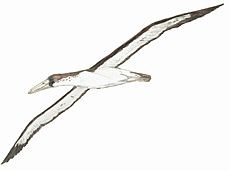 Life restoration of the Oligocene-Pleistocene false-toothed bird Pelagornis
Life restoration of the Oligocene-Pleistocene false-toothed bird Pelagornis - Pristis: The sawfish, a type of ray with a long, saw-like snout.
-
Rhincodon typus: The whale shark, the largest fish in the world, still alive today.
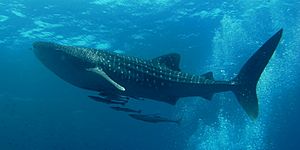 A living Rhincodon, or whale shark
A living Rhincodon, or whale shark - †Psephophorus: An ancient sea turtle.
- Corbula: A basket clam.
- Lucina: A type of marine clam.
- Ancilla: A type of sea snail.
- Busycon: A large sea snail.
- Acteocina: A barrel-bubble sea snail.
- Atrina: A pen shell, a type of large clam.
- †Choneziphius: An ancient beaked whale.
- Cladocora: A stony coral.
-


